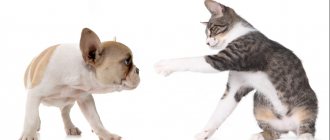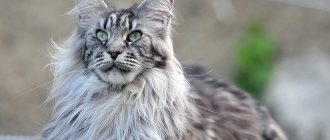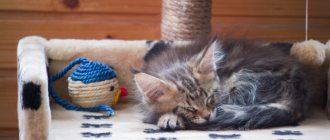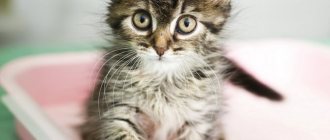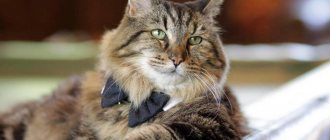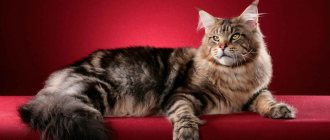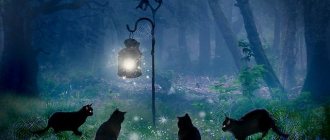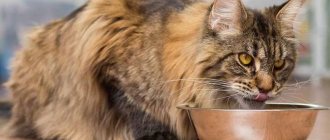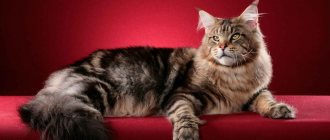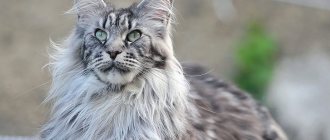The Maine Coon or American raccoon cat is an indigenous breed native to North America, from the state of Maine, bordering Canada. The name of the breed comes from the name of this state (Maine). The second part of the name (“kun”) was added already in the 20th century and is derived from the word “rekun” (from the English racoon - “racoon”). Maine Coons are considered the largest breed of domestic cats in the world and one of the most popular today.
“The raccoon cat from Maine” has long lived on farms near humans and its responsibilities included protecting grain and supplies from rodents. It is only natural that these intelligent animals found their way to the hearts of their owners and became dearly loved as pets, and not just as useful and good workers. This cat most likely resulted from crossbreeding of domesticated shorthaired and longhaired cats brought with the first ships of European settlers and traders from Asia Minor to Maine and other parts of New England at a time when cats were not yet registered.
Maine Coons are the natural population of the American cat metropolis. Nature took part in its creation for many years, which made these cats strong, physically resilient animals. Living semi-wildly on farms, in villages, and often just on the streets, these intelligent cats were able to survive by adapting to the harsh New England climate so that they could breed again the following season. When creating a cultural breed, breeders only have to consolidate these factors.
The favorite pastime of rural residents in those days were fairs with various competitions: cowboy competitions, dog and cockfights, horse racing. But not only gambling competitions were popular. American “gigantomania” has given rise to the desire to grow the biggest pumpkin, the biggest bull, the biggest cat. During the 1850s and 1860s, such competitions became so popular that farmers created their own cat show at the Skowhegan Fair, where only Maine Coon ancestors competed for the title of "Maine State Champion Coon Cat." Perhaps those first fair entertainments gave the first impetus to selection - competing farmers sought to get the biggest cats.
Legends about the origin of Maine Coons
The history of Maine Coons contains many mysteries and myths. There are romantic options based on external features, and the scientific opinion of zoologists about the origin of these cats. The only thing that has been reliably established is that the geography of origin of the breed is America, Maine.
Marriage between a cat and a raccoon
The myth about the close relationship of these animals tells that cats brought from Asia to the northwest of America crossed with raccoons. To confirm this theory, the color and tail of these animals are compared. These figures are actually similar.
However, from a genetic point of view, such a union is impossible, because The set of chromosomes in these animals is different. This version was liked by the owners of this breed, but is not confirmed by scientists.
Another legend says that Maine Coons were the result of a mating relationship between a cat and an American lynx, because they are large in size and have tufts on their ears. However, according to scientists, animals could not have arisen as a result of such crossed interspecies relationships.
Cat on a ship
One theory about the origin of the Maine Coon is that it was created by crossing American Shorthair cats with Asian Longhair cats brought from Asia Minor on a merchant ship.
There is a beautiful legend about the English captain Kun, nicknamed Raccoon, who took cats with him on his voyages. His favorites were large in size and had long hair. They hunted mice.
Because Maine was a major trading place, ships visited frequently. After each sailor’s trip to America, his pets brought offspring. He loved to give kittens to his friends.
In another version of the story, the captain distributed the over-increased offspring to the residents of the state. Thus, the union of Captain Coon’s cats with local American animals produced the Maine Coon breed, which translated means “Maine raccoon.”
According to another legend, Scandinavian sailors took cats with them on ships to hunt rats. These were large and hardy individuals, accustomed to harsh living conditions. After the ship entered the port, they went ashore along with the sailors and crossed there with aboriginal cats.
One of these stories tells about a cabin boy named Tom Kuhn. When the ship arrived at a Maine port, he sold the kittens born on the ship to a local woman. They became the progenitors of Maine Coons.
Another mythical version says that this breed originated from accidentally surviving animals of the lost continent of Atlantis. One cat ended up in Russia and gave rise to the population of Siberian cats, another in Norway, where the Norwegian variant appeared, and the third was the ancestor of Maine Coons.
Connection with the Queen
They tell the story of how the French Queen Marie Antoinette wanted to escape from the prison in which she was imprisoned by the revolutionaries, and ordered all her wealth to be loaded onto ships sailing to America. Among them were the queen’s favorite cats - large and fluffy.
The queen was unable to escape, but her ships reached the shores of America. Marie Antoinette's pets mixed with local animals, and the Maine Coon breed appeared.
Viking deity
These ancient warriors deified cats, associating them with the goddess Freya. The warlike Scandinavians repeatedly reached the shores of America before Columbus visited there. They took with them on the ship the ancestors of today's Maine Coons, brought from the countries of the East.
Presumably, these were Norwegian cats - large and shaggy, accustomed to difficult living conditions. There is a legend that the animals escaped from the ship and produced offspring by mating with local shorthair cats.
This assumption is confirmed by genetic studies, because Scientists have confirmed the genetic relationship of Maine Coons and the Norwegian wild cat.
However, scientists claim that all the myths about the origin of these animals have no basis in reality and are simply beautiful fairy tales.
Other versions: from fairy tale to reality
Experts are a little skeptical about the romantic legends about the origin of the popular breed. Most felinologists adhere to the version that the history of the breed began with the crossing of local short-haired cats with their long-haired relatives, brought by sailors to the American continent from Europe.
Official felinology holds the following opinion about the Maine Coon breed: the first Maine cat was born from a union between a long-haired forest cat that arrived from Europe with the Viking pioneers, and a North American aboriginal cat, which was not yet domesticated. Centuries passed, and gradually, under the influence of the harsh climate of the East Coast, the standard of the Maine Coon breed was formed - powerful, handsome cats, distinguished by magnificent hair, thick and silky, capable of protecting from frost and cold winds, as well as an imperturbable Nordic character. Today, the Maine cat is one of America's national treasures, and rightly so.
Aborigines of the Isle of Man
All breeds can be divided into two types:
- artificially bred;
- Aboriginal.
Artificial breeds were formed by people through crossing, but with native ones everything is a little more complicated. In a certain environment, a certain population is formed, it adapts to the climate, consolidates its main features, and the fittest individuals survive and develop.
Kosei cat, the first representative of the breed presented at the cat exhibition in 1895.
The native cats, from which the modern breed began, developed in harsh conditions. The North American state of Maine is characterized by cool summers and long, cold winters. In such a difficult climate, the ancestors of modern cats had to lead a predatory lifestyle in order to compete with other animals.
The cats were distinguished by a long, dense fur coat, a fluffy tail and a strong, muscular body. A thick fur coat provided protection in winter, and long legs helped to move through the snow. The huge tail allowed them to sleep on snow cover and in cold burrows. By wrapping themselves in their tails, they protected their sides and belly from freezing. Long mustaches helped hunters navigate at night; the ancestors of the Coons ate mainly birds and rodents - sharp teeth served as good weapons.
Modern Maine Coons sometimes resemble their relatives. Some animals have powerful fangs protruding from under the upper jaw. The elongated snout allowed predators to hold large prey.
For a long period of time they lived near farms, protecting supplies from rodents. Villagers viewed cats as hunters and were of little interest to their pets' appearance. Maine Coons were considered excellent rat catchers; residents tamed the animals to protect barns from mice. Gradually, the appearance of American cats began to gain popularity. In addition, the animals were distinguished by their friendly nature, and they began to be appreciated. Events took place 150 years ago. The Kuna began to spread deeper into the continent.
Reliable information about the breed begins to appear in the mid-nineteenth century. At this time, a cat exhibition is taking place, at which one participant presents a new breed - the “raccoon cat”. The large, long-haired cat quickly gained popularity.
Raccoons from Maine
The history of the Maine Coon breed takes us back to the American state of Maine. It is believed that the cats got their unusual name due to their resemblance to raccoons. Indeed, in appearance, Maine Coons are somewhat similar to raccoons - in build, large tail, color. Even the sounds made by young raccoons are somewhat similar to the purring of a cat. That is why the literal translation of the Maine Coon breed from English will mean: Maine raccoon. The first word is a reference to the name of the state (we'll talk about it later), and the second is a residual from raccoon, which is exactly “raccoon”.
Let's talk about the second one right now. The main legend about the history of the Maine Coon breed is as follows: it was born after crossing a female raccoon with a cat. Well, since they are similar, then there is nothing to deny. However, cats of many other breeds also have stripes similar to raccoons. And the Maine Coon cat got its large shape through natural selection. In addition, the impossibility of interspecific crossing has been scientifically proven. So, solely the evolution of the species and neither the raccoon nor the lynx (the tasseled ears of the Maine Coon remind many of this predator) took part in the breeding of this cat breed.
Publication and recognition
The Maine Coon actually almost joined the list of cat breeds that have disappeared forever. For some time, due to the small size of the group, he was even deprived of breeding status in the records of the national association, which is necessary for further registration of the breed.
Only in the 70s, through the efforts of enthusiasts, was it possible to return the big cat from historical oblivion.
- 1973 – organization of the American Maine Coon Fans Club.
- 1975 – preliminary recognition status in the CFA (Federation of Cat Fanciers and one of 9 participants in the World Felinological Congress).
- 1976 – obtaining permission to award the champion title in the Maine Coon breed.
From that moment on, the dark years in the fate of big cats ended, and a white streak began. In 1985, the Maine Coon was officially registered as the state breed of Maine.
Felinologists and breeders also rushed to make up for lost time. The Maine Coon has new colors, and breeders have adopted a national breeding program and identified only three breeds of cats with which the furry giants are allowed to be crossed.
The real history of breeding
The creation of animals that have established characteristics occurs in two ways:
- natural (aboriginal) way;
- man-made, i.e. through artificial crossing and subsequent selection of the best specimens.
Biologists consider the Maine Coon breed to be “aboriginal”, i.e. descended from wild ancestors who lived in Maine, and not artificially bred.
These felines received their qualities as a result of natural selection associated with the harsh climatic conditions of this place.
Gradually, the ancestors of Maine Coons adapted to their environment. Thick long wool covered them from the cold. Long legs made it possible to walk in the snow, and a thick fluffy tail made it possible to sleep on it. The large, furry cats were good hunters of rodents and birds, which they ate.
Rats, mice, etc. damaged the property of farmers who began to domesticate these animals. They lived on a farm and walked in the forest. They did not require much care and did not cause any trouble.
Gradually, Maine Coons became pets and rid the household of pests. Every owner wanted his cat to be better than others. Therefore, the largest cats were selected to produce offspring. So these animals acquired large sizes over time.
Living among people made them friendly and affectionate. After several generations, Maine Coons acquired distinctive features dictated by their living conditions.
This breed was first demonstrated at an exhibition in New York in 1861, and it was officially registered with the felinological organization in 1908. The fame of these animals did not last long - 30 years later Persian cats came into fashion. But American felinologists worked to improve the qualities of Maine Coons.
In 1980, this breed again gained fame on all continents. In America it is still considered the 3rd most common.
Considering the beautiful appearance of these cats, their size and friendliness, they began to be selected. Standard indicators for this breed were established in 1967.
In Europe, the first Maine Coon appeared in France in 1981. A little later, in the mid-80s, this breed was brought to England, where they now occupy 2nd place in the ranking. They appeared in Russia in 1992 and are actively being bred and improved.
Further history of development
In America
Recently, the most popular version is about the American origin of Maine Coons. They are believed to belong to the local fauna and have always lived close to people. Some, in search of food, might decide to get to know a person more closely. Strong and dexterous hunters helped farmers save their crops from the invasion of mice, rats and other small rodents. They lived on the street and got their own food. The owners cared little about their appearance and amenities.
Longhaired cats have appeared regularly at local fairs in Maine since 1850, taking prizes. The breed was first presented to the general public at an exhibition in 1861. A cat named Captain Jenks was shown; he is also considered the first Maine Coon to be officially recognized. The audience was delighted with the huge, fluffy handsome man.
At the 1878 exhibition in Boston, 10 representatives of the new breed already participated. Then, in 1895, New York took over the baton. However, the triumph was short-lived. By the end of the 19th century, a fashion for Persian cats appeared in society, and the wild giants were forgotten for many decades. The cats again took up their usual business - hunting mice and rats on farmland.
In 1967, a standard for the breed was adopted, kennels appeared, and by 1980, about a thousand Maine Coon owners were registered in America. A new surge of interest in these animals is beginning, not only in the United States of America, but also in Europe, Russia and other parts of the world. Currently, the breed occupies a confident leading position in popularity.
In Europe
In 1981, a cat named Charlie was brought from the United States to France. He is the founder of the French branch of Maine Coons. Cats were brought to the UK a little later - in the mid-80s, and now occupy second place in the ranking. In 1993, a souvenir coin with the image of a Maine Coon was issued in the kingdom. Animals very quickly spread throughout Europe, interest in them is constantly growing, hundreds of nurseries have been created specializing in breeding this breed.
In Russia
Several Russian breeders are vying for primacy in opening American longhaired cats for our fanciers. According to one version, Maine Coons were first imported from the Netherlands in 1992. The breeding of a new breed in our country began with these two individuals. According to another, this happened in 1989, and the cats arrived from America.
The third owner, Irina Guseva, claims that her animals (purchased in the late 1990s) are the true representatives of the species. Subsequently, the breeder brought several more purebred individuals from the United States. Currently, the descendants of these cats are in great demand both in Russia and Belarus, as well as in Ukraine.
At first, Maine Coons were something new and unusual; they rarely took part in exhibitions. But soon the breed found numerous fans, and now cats from domestic catteries are in no way inferior to their foreign counterparts.
Reviews
The description of the breed in reviews of Maine Coons is mentioned most often. Every owner can spend hours admiring their pet. Owners write enthusiastically in reviews about the size of the cats, which impresses everyone they know, about the tufts on the ears, and the fluffy tail. Breeders note the animal's sweet and cheerful disposition. The ease of care makes the breed very easy to keep. Maine Coons very quickly get comfortable in any home and feel like full members of the family. The cute creature, despite its large size, is distinguished by its mobility and will not let its owners get bored. But at the same time, Maine Coons are not prone to mischievous tricks, after which the whole house is upside down. The breed is good in many respects, for which it has earned universal love.
Basic moments
- Maine Coons are the giants of the cat world. The weight of an adult male can reach from 7 to 12 kg, of a cat - from 4 to 7.5 kg.
- Maine Coon owners like to call their pets simply coons.
- Despite the presence of a rich “fur coat,” representatives of this breed do not need professional grooming and can get by with home combing.
- Coons are not phlegmatic and will gladly support any game if it starts in the morning or in the evening. But in the daytime, animals prefer to take a peaceful nap.
- Maine Coons are rightfully considered one of the best family breeds. They equally easily take root in houses and apartments and do not declare war on other representatives of the fauna that are forced to share a common territory with them.
- With age, representatives of this breed “grow” an incredible sense of self-esteem, selflessly indulging in royal reclining on all free (and sometimes occupied) horizontal surfaces in unexpected poses.
Maine Coons are plus-size cats, wise, good-natured, with soft fluffy fur and funny “tassels” on the ears. Born hunters and strategists, they are happy to engage in active games, but at the same time carefully measure physical activity, alternating periods of vigorous activity with passive rest. These charming giants have a developed intellect, but are absolutely not vindictive. They masterfully “read” a person’s emotional mood from his voice and facial expression, so they always know when and from which side to approach the owner for their portion of affection.
Selection today
Now all over the world, incl. and in Russia, the Maine Coon cat breed ranks first in the ratings. Numerous nurseries are engaged in artificial breeding of cats of this breed and are working to improve the breed through artificial selection and crossing.
Previously, only the black marbled color of the animal was recognized. Now any options are allowed.
European felinologists understand the importance of American roots when breeding Maine Coons, and therefore value cats brought from their historical homeland.
Interest in Maine Coons periodically increased and fell again, because... new breeds appeared. But this species is not giving up its position. Now he is again among the most recognized. These cats participate in international exhibitions of world significance and receive high awards.
Russia
The first two cats of this breed were brought to Russia from Denmark in 1992.
These were animals from Narnia's nursery.
In those years, Maine Coons were very rare in the country and it was rare to meet them even at large Russian exhibitions.
However, this breed quickly found its admirers, and many professional breeders began to breed Maine Coons. In their breeding work, they used and continue to use now not only Danish bloodlines, but also animals exported from the USA, Finland, Holland, Germany, Austria, Poland, Britain and South Africa.
Thanks to correctly selected blood combinations, Russian breeders have managed to ensure that domestically bred cats are successfully exhibited at major international exhibitions and are serious competitors to Maine Coons from foreign catteries.
Character traits
At first glance, the unrealistically large size, meaningful look and luxurious fur are striking, although this is not all that can attract a person’s attention. People who are the owners of these animals can talk about their pet for quite a long time and surprise the interlocutor.
Cats play like little kittens, with enthusiasm, and during games they look funny and it is impossible to watch them without smiling.
And when the owner is doing some kind of work and is particularly busy with it, his pet will not leave this matter unattended and will definitely go to “help”. The cats will remain nearby throughout the entire activity, or until the work is completed.
When people come to visit, they are afraid at the sight of a large animal and often think that they will be attacked and at least scratched. But all this is in vain, they are very gentle and affectionate, they love peace, and can meet anyone with a perky purr.
The Maine Coon grows from 3 to 5 years, and small kittens are very easy to train.
Earlier it was said that they are hunters and therefore it is advisable to make a tree for them at home to make their well-being more comfortable. It is recommended to calculate such a structure based on the maximum weight of the animal when making it yourself or purchasing it at a pet store.
Its presence in the interior is necessary for sharpening claws, climbing and various games. It is desirable for cats to have an individual space where no one will disturb them. Having matured, Maine Coons do not play with the same passion as little kittens, they are lazier, but, nevertheless, their interest in observing events does not go away.
Sometimes the desire to run and frolic also attacks adult animals, so they need a specially allocated place, taking into account their large size. If you give them a tasty piece to eat, for example, a chicken breast, then they don’t eat it all right away, but after trying a piece, they begin to play with it, pushing it far under the furniture, where possible. During the game, they can perform various virtuoso acrobatic exercises and tricks, and you can watch them throughout the entire show.
These cats amaze with their self-confidence and self-esteem. They do not have the habit of climbing on the table and stealing food, even if they are hungry, they will never even ask for food, because they have a sense of pride from birth.
They find a common language with representatives of other animals, and communication is successful, despite their natural pride. They also respect dogs and do not react to their approach by hissing and ruffling them, like ordinary cats.
But if there are mice or rats at home, then we can assure you with one hundred percent certainty that soon there will be none left, because Maine Coons are excellent hunters.
If the house is filled with flies or midges, then there is no doubt that the cats will catch them all. They can simply look at the birds from the window without making any attempt to catch them. In addition, if a cat was raised with other representatives of small animals, then he is accustomed to them, so they do not need to be afraid of him. Maine Coons are also indifferent to aquarium fish.
And here is another difference from ordinary cats: they never meow, but utter sounds that, due to inexperience, cannot be distinguished from human ones. When cats say something, you can hear the difference in the shades of their voices, so many owners understand what their favorite cat is talking about. And another revealed fact is that they are intellectuals and understand their owners perfectly, they never wake them up in the morning, even if they are very hungry.
No less noticeable is such a character trait as accuracy. For example, if something is spilled on the floor, the cat will definitely go around it so as not to get dirty. They can go to bed in any place, and the positions taken at this time can be unimaginable and masterly, which cannot but cause surprise in any person who sees it.
Many owners of this breed claim that their pet knows much more than the owner how things are in the house. Since Maine Coons are smart and naturally well-mannered, they are distinguished by their intelligence.
There is no need to spend a lot of time for the training process, since the animal understands words perfectly. Many people believe that these cats are smarter than some people.
Is it worth buying a half-breed kitten?
Most owners prefer mestizos not because of their external features, but because the price is lower than for a purebred cat. It is also believed that if the baby has purebred parents, then genes will appear in the kitten. However, in most cases this opinion is erroneous.
Half-breed is an unpredictable pet
It should be understood that a half-breed is not the same thing as a purebred cat. No one can ever guarantee what a kitten will look like when it grows up and what its character will be like. The reason is precisely that purebred Maine Coons are freedom-loving, and even the British gene cannot correct this.
The correct approach to breeding is also important. Irresponsibility can result in a mixed-breed kitten becoming aggressive, sickly, or mentally unstable.
Advantages and disadvantages of a crossbreed
The positive aspect of such half-breeds is their low cost. Most mestizos are friendly and sociable, but there are exceptions. Another advantage is flexibility and affection for a person.
Also, the Maine Coon gene has a positive effect on the intelligence of a cat. Such animals understand and remember commands well and quickly get accustomed to the tray.
As for the disadvantages of mestizo, first of all it is the loss of a thoroughbred pedigree. In this case, there can be no talk of any exhibitions. In addition, if a male and a female of a smaller breed are crossed, there is a risk of death of the mother due to the birth of a large fetus.
Important! If a person nevertheless decides to get a crossbreed, it is worth contacting an experienced breeder to rule out problems with the health and psychological state of the animal.
Difficulties and possible illnesses
The breed is hardy and has good health, but cases of illness still sometimes occur. Among the most common diseases is hypertrophic cardiomyopathy.
Spinal muscular atrophy is also among the most common. This disease is hereditary, so the cat’s parents and their health are an important factor when buying a pet. This disease is incurable, it leads to muscle weakness and complete atrophy. Hip dysplasia is also a hereditary disease. It is characterized by severe pain and even lameness of the animal. The disease is not fatal, but it often causes osteoarthritis. To avoid these and other diseases, take your Maine Coon to the veterinarian periodically. He must monitor the health of the animal, then you will not have to worry about the well-being of your pet.
The main rule of keeping a cat is love and respect for him. Before you decide to get yourself a four-legged friend, make sure you are ready to take on this responsibility.
pets2.me
Advantages and disadvantages of a crossbreed
A mixed breed born from a Maine Coon has advantages, but more disadvantages.
- high probability of having genetic abnormalities that appear in the first generation;
- aggressive and uncontrollable behavior after reaching puberty;
- partial presence or complete absence of breed characteristics of appearance;
- exclusion from participation in competitions;
- lack of documents indicating pedigree;
- the impossibility of crossing with an ordinary cat, since the process of giving birth to large cubs can end in the death of the female.
- good health;
- lower cost;
- the opportunity to participate in competitions for outbred pets.
Description of the breed
Animals of this breed are large in size; cats are much larger than cats. The average weight is from 8 to 10 kilograms. There are specimens weighing 12 kg. The body length from the nose to the tip of the tail is about 130 centimeters, with half the size being a luxurious, fluffy tail. The height of the paws is 40-42 cm. However, with such sizes, cats do not look massive and clumsy; they have a large head, a wide chest and a muscular body. These are born hunters.
Maine Coon wool has an interesting property - it is almost impervious to moisture and does not get wet. Moreover, it has different lengths: there is a chic “collar” on the neck, the hind limbs are dressed in “fur pants”, there is thick fur with undercoat on the back, sides and belly, and the head and paws are covered with shorter hair. The shape of the paws resembles snowshoes - they are wide and powerful, with hairs growing between the toes.
This breed has interesting, unique ears - large, located high on the head, with thick skin, covered inside with fur, and outside with dense hair. At the very tips there are tassels, like a lynx. All of these properties helped these cats survive and get food in the harsh places where they came from. The officially recognized homeland of Maine Coons is Maine, United States of America. Farmers specially bred cats to combat rodents that spoiled grain.
It is believed that animals began to be actively domesticated approximately 150-200 years ago. As in any other business, competition and excitement arose between people. Everyone wanted their cat to be bigger than the one on the neighboring farm. Therefore, only the most outstanding individuals were left for the tribe. Thus, the breed was gradually formed. Despite their rather impressive size, cats have a calm, balanced character. They are not aggressive and are trainable. They become attached to their owners and get along well with children.
Features of maintenance and care
The Maine Coon is a large, strong and active cat, and this must be taken into account when planning to purchase a pet of this breed. These cats need space, they like to explore high places in the apartment and play actively.
The best option would be a special corner for cats, with platforms of varying heights and a house.
If the cat does not exercise enough, this will lead to obesity and various diseases, which will negatively affect life expectancy.
In the absence of a special corner, you can equip a bookshelf for your pet, hanging it on the wall, or a chair intended only for it. It is important for the Maine Coon to know that he has a personal space that he can inhabit as he pleases (although cat owners know that he usually considers the entire apartment to be such space).
When getting a pet, every person should remember that he needs attention and care, then he will live long and happily. In order for the animal to be healthy, it is necessary to regularly show it to the veterinarian for medical examination.
In addition, the mustachioed friend needs vaccination.
The first vaccination is given at the age of two months; it develops complex immunity to viral infections, chlamydia, tracheitis and pylencopenia. The following are done according to the schedule recommended by the veterinarian (there are special instructions that indicate the approximate vaccination schedule). It is developed taking into account not to overload the animal’s body with drugs, but also in such a way that by the age of teething (when the immune system is significantly weakened) the necessary protection is formed.
The second vaccination is given to the cat at approximately three months of age; it must be vaccinated against rabies. The next procedure is per year, and then annually or as necessary. 10 days before vaccination, the kitten must take a course of antihelminthic medications.
Immediately before vaccination, the cat will be examined by a veterinarian, since the procedure can only be performed on a completely healthy animal.
To improve your pet’s immune status, the health of its eyes, fur, teeth, and musculoskeletal system, you should regularly give it vitamin complexes. It is better to select them together with a veterinarian. He will advise which vitamins are most suitable for a particular cat.
Antiparasitic drugs must be given in courses, regularly. It is also necessary to regularly treat for fleas and ticks. All these measures are especially necessary for Maine Coons who walk outside.
Representatives of the breed are very clean, constantly washing themselves and licking their fur. It accumulates in lumps in the stomach and is periodically regurgitated naturally. But if the owner wants to take care of the health of the furry pet, then the animal should be given special pastes that help remove hairballs from the gastrointestinal tract.
In some cases, hairballs are so large that they can block the intestinal lumen, causing obstruction. This is a dangerous condition, so it is better to take care of hair removal in advance.
In order to improve digestion, felinologists also recommend purchasing special pots of weed or growing it at home yourself. Cats nibble grass, which helps cleanse their intestines better.
Maine Coons have luxurious thick hair, which in natural conditions helped them easily endure the rather harsh climate of their homeland. A cat living at home needs help in caring for his luxurious fur coat. The animal should be combed 1-2 times a week, and during the molting period - even more often, daily. It doesn't take much time, and many cats even really like the procedure.
For combing, a natural bristle brush or a fine-toothed comb with a metal base is suitable. Long, thick hair can become tangled, especially if brushing is not done regularly. You can try to carefully separate the matted wool with your fingers, and if that doesn’t work, then cut it off.
Most often, Maine Coon hair falls off on its “pants.” In order not to cause discomfort and pain to your pet, before combing it is necessary to check for the presence of tangles.
You should bathe regularly, using special shampoos and conditioners. A special feature of this breed is a noticeable love for these procedures: many of them love to play with a trickle of water, splash around, drink from the tap and even take a full bath. Because of this feature, they tolerate the washing procedure quite easily and even with pleasure.
Before bathing your pet, you need to make sure that water does not get into its large ears. To do this, you need to protect them with cotton swabs.
Caring for a cat of this breed also includes regular cleaning of the ears with a special solution, teeth and claw trimming. You can do all these procedures yourself, or you can take your pet to a groomer and veterinarian.
Main features of raccoon cats
Maine Coons develop slowly, only by the age of five do they reach maturity, becoming more than a meter long, and weighing up to 15 (or even more) kilograms (males). These giants are gentle and good-natured, despite their formidable appearance.
They have a slightly elongated head, a slightly curved profile, and high cheekbones. The ears are quite pubescent, and at the tips they are decorated with almost lynx-like tassels.
Coons also have incredibly long mustaches, which helped them, when living in the wild, not to stumble upon bushes or tree branches in the dark.
The body differs in its length. But the Coons have the same long tail - their real pride. For a cat, this is a fairly essential element of survival. It protects the animal from the cold. When he has to lie on the frozen ground, he wraps himself in this shock of six, keeping warm.
Many animals with long fluffy tails do the same. He also plays the role of a “steering wheel” that coordinates Kun’s movements.
The fur of these giant cats is dense and long, which is characteristically water-repellent and protects from external influences.
To what age do they grow?
Maine Coon kittens are born larger than normal kittens; by the age of three months they can weigh up to 2 kg. They become fully formed with a large build and a large head, the tail is long, the paws are thickened and fluff forms between the toes. Subsequently, as Maine Coons grow, they develop differently, but more slowly and are finally formed in size and weight only by 3-5 years.
Training and communication
Maine Coons are very sociable animals; they love to be in human company. Pets need to be raised from as early an age as possible.
The first thing cats must learn is to use the toilet, as well as a scratching post. This breed is highly trainable; they can easily be taught anything using carrots and sticks. But do not overdo it with the punishment system, otherwise the stress-prone animal will feel bad. For example, you can wean an animal from jumping on a sleeping bed or scratching a sofa using a spray bottle. The water in it should be warm, you need to splash the animal very little: do not allow the fur to be too wet so that water gets into the eyes.
Before punishing an animal for disobedience, think about whether it is to blame for the current situation. Perhaps you yourself did not take care of finding a comfortable place to sleep, or installing a scratching post or tray in an insufficiently secluded place.
